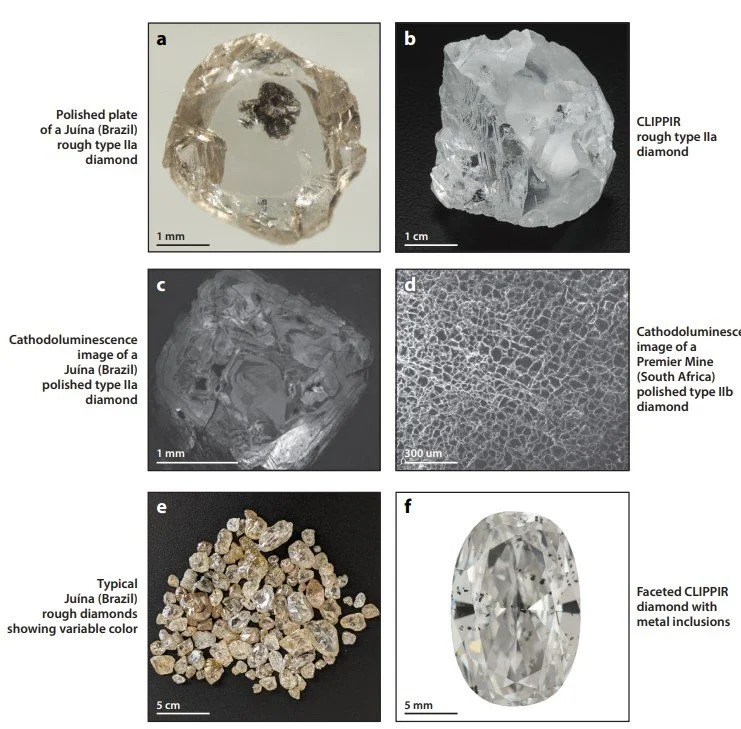Evan Smith on Diamonds from the Deep Mantle
Listen to the podcast here or wherever you get your podcasts.
Evan Smith was one of the first to recognize that among the rare diamonds that come from the very deep mantle, a highly prized few belong to a distinct class. These so-called CLIPPIR diamonds contain inclusions that give us a new source of knowledge about the mantle. And, as Smith explains in the podcast, analysis of the inclusions suggests a direct link to subducted oceanic lithosphere. According to the hypothesis Smith favors, when the subducting slab reaches the lower mantle transition zone at a depth of about 650 km, carbon in the form of diamond, and other light elements separate out from the slab and rise to the base of the lithosphere as buoyant diapirs. They then reside there until violently brought to the surface along kimberlite pipes.
Evan Smith is a Senior Research Scientist at the Gemological Institute of America, New York.
Podcast Illustrations
Cullinan Diamond
The Cullinan Diamond (left) is the largest gem-quality rough diamond ever found. Weighing in at 3,106 carats (621 g) it gives its name to the new class of deep-mantle gem-quality diamonds discussed in the podcast: Cullinan-like, Large, Inclusion-Poor, Pure, Irregular, and Resorbed (CLIPPIR). The largest cut clear-cut diamond in the world is the 530-carat (106 g) Cullinan I, taken from the Cullinan Diamond. It is mounted in the head of the Sovereign’s Sceptre of the Crown Jewels of the United Kingdom (right).
A variety of diamonds that formed below the lithosphere. The examples shown in b and f are CLIPPIR diamonds. In the latter, the inclusions appear as black spots.
Shirey, S.B. et al. (2024), Annual Review of Earth and Planetary Sciences 52, 249. From a to f, courtesy of Janina Czas, EPL; Gem Diamonds Ltd., Robert Weldon; Bulanova G. P. et al (2010), Control. Min. Petrol. 160: 489; Regier M.E. et al. (2023), Earth Planet. Sci. Lett. 602: 117923; Janina Czas, EPL; Smith E.M.
Metal inclusion
In this magnified view, a metallic inclusion is a reflective silver in appearance and is surrounded by a black, graphite-bearing decompression crack. The image is 2.5 mm across.
Photo: Evan Smith
Karowe mine in Botswana, which is an important producer of CLIPPIR diamonds. The 1,109-carat Lesedi La Rona diamond (right), the fifth largest diamond ever found, was found at the Karowe mine.
Diamond photo courtesy of Lucara Diamond
Mantle mineralogy diagrams for two major rock types in the mantle — peridotite (left) and basaltic ocean crust (right). These are the rock types of which the convecting mantle and the subducting oceanic lithosphere are made. The diagrams show what minerals make up these rocks as a function of depth in the Earth. As you go deeper, the constituent minerals change. Majoritic garnet, which is one of the tell-tale high-pressure phases present in CLIPPIR diamonds, is shown in purple. Rock names are shown in the gray columns at right, with lherzolite and harzburgite being forms of peridotite, the main rock type of the mantle. The other rock names are new ones proposed by Shirey, S.B. et al. (2024) based on their mineral assemblages. cf = calcium ferrite; cpx = clinopyroxene; NAL = new aluminous phase.
After Shirey, S.B. et al. (2024), Annual Review of Earth and Planetary Sciences 52, 249
Cartoon model showing a cross-section of the Earth with a thickened ancient continental lithosphere, which is where most mined diamonds come from. The 660-km-depth line marks the top of the lower mantle and a transition zone where the seismic velocity changes, indicating changes in the mineral phases across the transition zone. The cartoon shows a subducting slab releasing hydrous (blue) and carbonatitic (red) fluids that contribute to the growth of sublithospheric diamonds. As Smith discusses in the podcast, these fluids also contribute to the evolution of metallic liquid from which the CLIPPIR diamonds grow.
Smith, E.M. et al. (2021), in Marquardt, H. et al. (eds.), Mantle Convection and Surface Expressions, American Geophysical Union, 179









